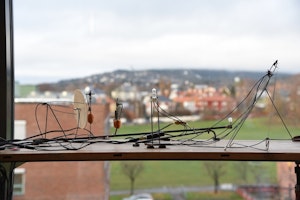Field of study: Artistic Research (Composition)
Christian Blom: Organized Time

How to compose a work where movement, sound and light are co-dependent and need connections for there to be a work at all?
Summary
Background
Christian Blom says:
" For many years I was a part of a performance group called Verdensteatret. We made large scale performances and installations. They were often dense with information. Speech, movements, video, lights, sounds and music, all utilizing their full scales at once, fast to slow, loud to soft, bright to dark and so forth. This meant that we had many situations where the amount of information was overwhelming. Anyone attending would have to make choices of where to focus and what to follow. I recall sitting in rehearsal for the work Louder (Verdensteatret 2007) thinking: Isn’t that sound finishing off Marius’ movement? They are both coming to a halt after finishing a similar arch through the room. And the sound continues ten seconds after Marius has stopped. They start together but finish separately. A connection appears as they separate. The connection is clear for the ten seconds between when Marius is finished, and the sound finishes in a similar manner as Marius did. Nothing else enters and connects more strongly to either and their initial connection is strong since they start out as if in unison. I didn’t think all this then, it’s only now that I can put words to it. After all, things are indications before they become phenomena (Bachelard 1958)."
This glimpse and Blom's imaginative memory is the basis for organized time. Through this research project, Blom has tried to recreate this glimpse, to isolate it and force it to show itself. It has been a hunt. He started fiddling about, juxtaposing things and hoping for a dialectic miracle, and as things became more clear, he increased precision and gradually formulated a strategy for transmedial composition.
Research questions
- Which qualities, in an element, can be accentuated to discover the element’s potential for connections and kinship in a temporal composition?
- Which qualities, in a composition, are accentuated by exposing it at different sites?
Material and outcome
Through the span of his project, Blom has worked artistically along parallel lines of notated music, electronic music, installations and finally performance.
He has divided the artistic output into categories of central works and surrounding works, giving the position of central works to those that pertain directly to the research questions. Surrounding works are included to cast a light on his practice as an artist and give a context to the central works.
Blom claims that transmedial composition is a little corner in the art world where media meet and are mutually dependent in a common structure.
– If my understanding of basic structures of time and intensity has any bearing outside my head, chances are I have obtained a new perspective on how to work across media as well as media-specific.
Blom hopes that his findings host an insight of value to dancers, musicians, performance artists and projects spanning new technology.
Results and documentation
Full title: Organized Time – Strategies for Transmedial Composition
The project comprises the following parts:
Artistic result
- Artistic presentation, Sentralen 16. June 2016.
- Central works: The Singer (2013), On Speed (20139, Strick, String and Light (2016), and Bring me that horizon (2016)
- Surrounding works: al Khowarizmis Mechanical Orchestra (2011), Lyrical Pieces (2013), and Weak Questions Strong Music, hats off to Burrows and Ritsema (2015)
Written documentation
A critical reflection
Published: May 31, 2016 — Last updated: Oct 24, 2025